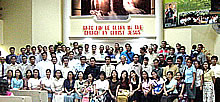About FIREPROOF, the movie
At work, inside burning buildings, Capt. Caleb Holt lives by the old firefighter's adage: Never leave your partner behind. At home, in the cooling embers of his marriage, he lives by his own rules.
Growing up, Catherine Holt always dreamed of marrying a loving, brave firefighter...just like her daddy. Now, after seven years of marriage, Catherine wonders when she stopped being "good enough" for her husband.
Regular arguments over jobs, finances, housework, and outside interests have readied them both to move on to something with more sparks.
As the couple prepares to enter divorce proceedings, Caleb's father challenges his son to commit to a 40-day experiment: "The Love Dare." Wondering if it's even worth the effort, Caleb agrees-for his father's sake more than for his marriage. When Caleb discovers the book's daily challenges are tied into his parents' newfound faith, his already limited interest is further dampened.
While trying to stay true to his promise, Caleb becomes frustrated time and again. He finally asks his father, "How am I supposed to show love to somebody who constantly rejects me?"
When his father explains that this is the love Christ shows to us, Caleb makes a life-changing commitment to love God. And so with God's help he begins to understand what it means to truly love his wife.
But is it too late to fireproof his marriage? His job is to rescue others. Now Caleb Holt is ready to face his toughest job ever...rescuing his wife's heart. (Read more About FIREPROOF; surf to the FIREPROOF blog) Fireproof Your Life
Fireproof Your Life
Like the movie itself, this new book from Michael Catt, senior pastor of Sherwood Baptist Church and executive producer of FIREPROOF, tackles real-life issues. With practical insights and wisdom, Fireproof Your Life encourages readers to fireproof key areas of their lives, including their marriages, finances, and faith.
Learn how you can build a faith that survives flames in Pastor Catt’s latest book. Fireproof Your Life is published by CLC Publications and is available at Christian bookstores and online. (Learn more at the Fireproof Your Life website) The Love Dare
The Love Dare
In FIREPROOF, Caleb Holt tells his father that he is about to get a divorce. Caleb's dad asks him to wait 40 days before moving forward. Dad's challenge: work a day-at-a-time through a handwritten book he calls The Love Dare.
Central to the movie's plot, The Love Dare is now available from B&H Publishing Group. Written by Alex and Stephen Kendrick, The Love Dare is hands-on study that both men and women can integrate into their marriages.
A deluxe "Legacy Edition" of the book will be available in early 2009. Look for The Love Dare at your favorite Christian store, online, or wherever you buy great books. (Visit LoveDareBook.com) The Love Dare Bible Study
The Love Dare Bible Study
This eight-week study is designed to help you lead your church or small group through the Love Dare challenge. It starts by showing the FIREPROOF movie to the group using the included DVD. Then each session reinforces the week's Love Dare teachings with added biblical insight, commentary, and provocative questions that spark lively and helpful group discussions. Session themes cover issues such as honoring your spouse, forgiveness, building marriage on prayer and God's word, unconditional love, and more.
The Leader Kit comes with a variety of resources to help make your group study a success:
- FIREPROOF movie on DVD
- The Love Dare journal
- Member Book with leader notes
- Teaching clips DVD
- Fireproof Your Life by Michael Catt
- CD-Rom containing sermon outlines and helps for church planning and promotion
 Fireproof Your Marriage Curriculum
Fireproof Your Marriage CurriculumAfter seeing FIREPROOF, couples will contemplate the state of their relationship. The FIREPROOF Curriculum from Outreach provides the opportunity for couples to work through these important relational issues.
Featuring clips from the movie, this curriculum is ideal for small groups, Sunday school classes, premarital classes, or for couples to do on their own at home. The six-part study challenges couples to look at love as a lifetime commitment.
- Study topics include:
- Forgiveness
- Marriage as a covenant
- God-designed differences
- Unconditional love
 Host A FIREPROOF Movie Event!
Host A FIREPROOF Movie Event! FIREPROOF touched the hearts and impacted the marriages of millions of moviegoers. Churches across the country purchased entire show times to help strengthen marriages in their congregations and to reach out to their communities. And those churches reported increased attendance in response!
That makes a FIREPROOF Movie Event a natural ministry tool to inspire and challenge the people of your church...and beyond.
Provident Films has partnered with Outreach to provide the official Site License DVD for FIREPROOF Movie Events at churches. (DVDs are not licensed for public group showings.) Outreach can also provide all of the Movie Event resources and materials you need to build interest and make a long-lasting impact!
Note: For articles on relationships. marriage and the family, please visit my Salt and Light blog.
 Marital infidelity: causes, consequences and conclusions; Mediation not allowed in domestic violence cases (with apologies to Pia Guanio); Why marriages fail: He said, She said; Transformers: Why do persistent suitors become passive husbands? How to save your marriage alone; All about women; Why do men think the things they think, say the things they say, and do the things they do? Surviving marital infidelity; Marriage: The Ultimate Fighting Championship; Legal lessons from Willie Revillame and Liz Amoro; Boundaries in marriage; and other articles
Marital infidelity: causes, consequences and conclusions; Mediation not allowed in domestic violence cases (with apologies to Pia Guanio); Why marriages fail: He said, She said; Transformers: Why do persistent suitors become passive husbands? How to save your marriage alone; All about women; Why do men think the things they think, say the things they say, and do the things they do? Surviving marital infidelity; Marriage: The Ultimate Fighting Championship; Legal lessons from Willie Revillame and Liz Amoro; Boundaries in marriage; and other articles










